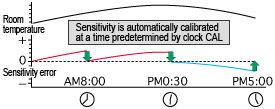Error Caused by Temperature
The following describes error caused by changes in temperature. The effect of this must be taken into consideration especially with high-sensitivity balances having a minimum indication of 1 mg or less.
● How Much Does Temperature Affect Error?
Let's try calculating how large this error actually is.
| Let's assume the following parameters: an analytical balance capable of weighing 200 g, and having a minimum indication of 0.1 mg and a temperature coefficient for sensitivity of 2 ppm/°C (typical average value for balances in this class). Let us also assume a change in room temperature of 5 °C. Assuming that a 50 g object is measured on this balance, how much error will occur with this change in room temperature? |
Answer: 50 (g) × 2 (ppm) × 1/1,000,000 × 5 (°C) = 0.0005 (g)
In other words, this means that 0.5 mg of 50 g is error.
Though it may be felt that this is not such a large error, attention should be paid since relative error increases, for example, when measuring slight changes in the mass of large samples. For example, when measuring the following change in mass,
(before chemical operation) 50.0000 g → (after chemical operation) 50.0032 g (change in mass 0.0032 g)
this means that the change in mass of 3.2 mg contains an error of 0.5 mg or 15 %.
Sensitivity calibration to match changes in room temperature is important to ensure accurate measurement. Shimadzu offers balances with built-in calibration weights capable of automatically calibrating sensitivity.
| Balances that automatically start calibration according to changes in room temperature The balance captures changes in room temperature that affect sensitivity and automatically starts calibration using built-in weights. This ensures that sensitivity is constant at all times, allowing the operator to concentrate on measurement tasks without having to worry about sensitivity calibration.  The PSC function keeps the sensitivity error in a fixed range at all times. Balances that automatically start calibration at user preset times The balance starts calibration using built-in weights at preset times of the day. If you set calibration times before important measurements (e.g. before starting work in the morning, or during the lunch or evening break), the balance will automatically start calibration when the preset time is reached. Consistent measurement is possible without worrying about sensitivity calibration.  For details, see "Features of Shimadzu Balances/Built-in Calibration Weights."
|


